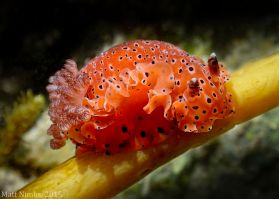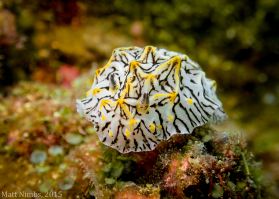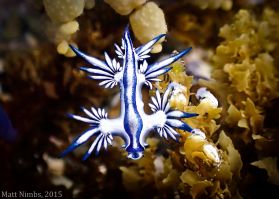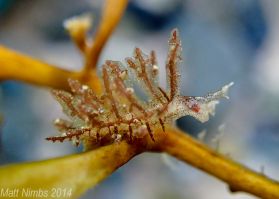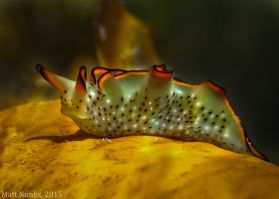| Absent: |
not present,
missing. |
| Abyssal: |
oceanic
waters between depths of
4000 m and 6000 m. |
| Accessory
respiratory structures |
organs composed of gill tissue,
not arranged into a
distinct set of gills, which are used for gas exchange. These tissues
are often attached to the cerata or other dorsal structure. |
| Aeolidiform:
|
similar in
shape and form to
animals from the family Aeolididae. |
| Algae/alga: |
non-flowering, aquatic plant;
seaweed. |
| Anal papilla: |
nipple-shaped
projection from
which waste products are excreted, often surrounded by gills. |
| Anemone: |
animals in
the class Anthozoa; sedentery marine cnidarian with a columnar body
which bears a ring of tentacles around a mouth.
|
| Angular: |
with corners. |
| Annual: |
living for
one year or less. |
| Annulate: |
thin,
ring-shaped lamellae. |
| Anterior: |
towards or
of the front. |
| Arborescent: |
tree-like,
branching. |
| Arc: |
a
semi-circle. |
| Arch: |
a semi-circle. |
| Ascidian: |
marine
tunicate in the class Ascidiacea with a sac-like body containing
orifices through which water flows into and out of a central pharynx. |
| Auriculate: |
with a structure shaped like an
ear. |
| Autotomise: |
to cast off
a body part voluntarily. |
| Axial
bands: |
bands on a
shell that are more or less parallel to the coiling axis. |
| Bifid: |
divided by a deep cleft or notch
into two parts. |
| Bilobed: |
having or consisting of two lobes. |
| Bipinnate: |
see pinnate. |
| Bivalve: |
animal enclosed within a hinged
shell. |
| Branched: |
with lateral extensions or
subdivisions extending from the main part. |
| Broad: |
wide. |
| Bryozoan: |
sedentary marine invertebrate in
the
Bryozoa; filter feeding colonial organisms that may encrusts rocks,
algae or may form
stalked fronds. |
| Buccal: |
related to
the principal feeding organs and their components. |
| Calcified: |
shell hardened by deposition of
calcium carbonate. |
| Carnivore: |
feeds on other animals. |
| Caruncle: |
elevated
ridge or lobe, with
presumed sensory function, between or close to rhinophores. |
| Caryophyllidia: |
microscopic sensory tubercules surrounded by spicules. |
| Caudal
lobe: |
lobe
associated with a tail. |
| Cavity: |
empty space within a solid. |
| Cephalic: |
associated
with the head. |
| Cerata/ceras: |
clustered
tubular outgrowths
along both sides of the
body. |
| Ceratal: |
relating to
cerata. |
| Circular: |
in the shape of a circle. |
| Circumference: |
boundary of a circle. |
| Clavus: |
terminal
expansion of a rhinophore,
formed of lamellae or papillae. |
| Cleft: |
split or divided , or partially
divided into two. |
| Club: |
terminal
expansion of a
rhinophore (formed of lamellae or papillae) or cerata (formed by
swelling of
the tip). |
| Clubbed: |
shaped as a club. |
| Cluster: |
a group of similar parts. |
| Cnidarian: |
marine invertebrate in the
Cnidaria; singular or colonial organisms characterised by a radially
symmetrical body with tentacles
that may possess stinging cells. |
| Cnidosac: |
a sac at the
tips of cerata that
contain functional cnidarian stinging cells (nematocysts) removed from
cnidarians during feeding. |
| Coiled: |
arranged in a coil; part circle. |
| Colonial: |
organisms that may form groups
or colonies. |
| Compound: |
made up of two or more
simple parts or individuals in combination. |
| Conical: |
shaped like a cone. |
| Constriction: |
an area where a shape has
narrowed or become tighter. |
| Contractile: |
capable of being contracted; to
be made shorter or tighter. |
| Convex: |
dome shaped; having a curved
outline like the exterior of a circle. |
| Coralline
alga: |
calcified, encrusting algae, usually pink or may be
white, grey or yellow. |
| Cosmopolitan: |
found world-wide. |
| Crenulate: |
finely
notched or corrugated. |
| Cryptic: |
animal that is coloured or
shaped to serve as camouflage. |
| Curved: |
rounded or bent in an arc. |
| Cyanobacteria: |
microorganisms related to
bacteria that are capable of photosynthesis. |
| Cylindrical: |
having straight, parallel sides
and circular or oval in cross-section. |
| Depressed: |
in a lower state, or pressed in. |
| Discrete: |
separate and distinct. |
| Digestive gland: |
simple to
complex organ linked by duct(s) or opening
directly to the stomach. |
| Dorsal/dorsum: |
relating to the
back. In sea slugs
the dorsum is
homologous to the mantle of
shelled gastropods. |
| Dorso-ventral: |
an axis associated with dorsal
and ventral surfaces. |
| Ecology: |
the relationship of an animal to
one another and its physical surroundings. |
| Egg: |
reproductive cells.; propagules. |
| Elongate: |
long in relation to width. |
| Embedded: |
set firmly and deeply within
surrounding mass. |
| Emulate: |
to imitate. |
| Epibenthic: |
living on the surface of the
bottom of the sea. |
| Epifaunal: |
living on the surface of the
bottom of the sea or attached to other marine animals or plants. |
| Exhalant
siphon: |
tubular
orifice through which exhalant water is
expelled. |
| External
Shell: |
calcified shell that is outside
the tissues. |
| Eye
spots: |
light-sensitive, pigmented spot. |
| Filiform: |
thread-like. |
| Flagellum: |
fine,
hair-like organ that may beat with an undulating rhythm. |
| Flaps: |
thin piece of tissue that is
hinged or hangs. |
| Flattened: |
made flat; depressed
between two surfaces. |
| Flexion: |
action of bending. |
| Foot: |
the
large muscle mass on which gastropod molluscs move, comprising the
pedal sole. |
| Fringed: |
with a border. |
| Furrow: |
a rut or groove. |
| Fused: |
joined, blended or united into a
single unit. |
| Fusiform: |
spindle-shaped,
tapering at both ends. |
| Gelatinous: |
jelly-like. |
| Genera/genus: |
taxonomic category that ranks
below family but above species.
(Genus = singular; genera = plural). |
| Gill: |
respiratory
structures, in
heterobranchs usually feather-like or formed of multiple leaflets. |
| Globose: |
spherical, rounded. |
| Gorgonian: |
a colonial coral that forms a
tree-like skeleton. |
| Head shield: |
structure
covering the head,
mainly in cephalaspideans, often with a shallow groove along the
midline and a
pair of rounded flaps. An
adaptation for burrowing. |
| Herbivorous: |
organism that consumes plant
material. |
| Horizontal
lamellae: |
lamellae
that are in a plane of the horizon; at right angles to the vertical. |
| Horn: |
curved outgrowth that projects
outside the body margin. |
| Host: |
animal or plant on which another
organism lives. |
| Hump: |
raised area, frequently convex. |
| Hydroid: |
animals in
the class Hydrozoa; sedentery marine cnidarian
with a columnar body that is distinctly polyp-like. |
| In
situ: |
in the original place. |
| Inconspicuous: |
not clearly visible. |
| Inflated: |
distended or exaggerated. |
| Infrapallial: |
fold of body tissue at the rear
of a cephalaspidean that may enclose the shell. |
| Inhalant
siphon: |
tubular fold
through which inhalant water is drawn. |
| Ink: |
defensive,
coloured liquid.
|
| Internal
shell: |
calcareous shell
held within the tissues. |
| Intertidal: |
an area that is covered and
uncovered by water depending on the tide level. |
| Keel: |
pronounced ridge. |
| Lamellae: |
thin,
plate-like structures. |
| Lamellate: |
comprised of
lamellae. |
| Lappet: |
feelers,
tactile flaps or additional folds associated with the mouth. |
| Lateral: |
relating to the side. |
| Leaflets: |
leaf-like structure. |
| Leathery: |
having a tough, hard texture. |
| Limaciform: |
resembling a slug or worm. |
| Lobe: |
round and flat piece of tissue
that projects or hangs. |
| Longitudinal: |
running lengthwise rather than
across. |
| Luminesce: |
emit light. |
| Mantle: |
the
integument surrounding the visceral
mass. |
| Mantle skirt: |
the extended
edge of the dorsum
or mantle. |
| Margin: |
edge or border. |
| Medial: |
situated in the middle. |
| Membrane: |
thin, pliable sheet of tissue
that forms a barrier or lining. |
| Morphology: |
study of forms or body shape. |
| Narrow: |
small width in relation to
length. |
| Neck: |
area
immediately posterior to the head. |
| Nemertean: |
a ribbon worm in the phylum
Nemertea. |
| Nocturnal: |
active at night. |
| Nodule: |
small, rounded lump of tissue
distinct from its surroundings. |
| Nudibranch: |
shell-less marine slug in the
order Nudibranchia. |
| Oblique: |
on a slanting line; not parallel
or perpendicular. |
| Ocelli: |
eye spot or eye-like spots. |
| Opalescent: |
lustrous with points of shifting
colour. |
| Opaline
gland: |
repugnatory
gland within the
mantle that produced
defensive products. |
| Opaque: |
not able to be seen through. |
| Oral: |
relating to the mouth. |
| Oral
veil: |
membrane
above the mouth. |
| Ovate: |
oval shaped. |
| Ovoid: |
round, circular. |
| Palmate: |
with projections that radiate
from a single point. |
| Papilla: |
small rounded protuberance that
is taller than its width (papilla = singular, papillae = plural). |
| Papillate: |
possessing papillae. |
| Parapodia: |
thin,
lateral, wing-like
expansions of the foot used to protect the shell
or viscera, also used
for
swimming. |
| Pelagic: |
of the open sea or water column. |
| Pericardial
swelling: |
dome
shaped protrusion below which is the heart and pericardium. |
| Periostracum: |
layer of
tissue that forms a protective outermost
layer of a mineralised shell. |
| Petiole: |
a distinct stalk. |
| Photosynthetic: |
able to produce chemical energy
products from sunlight. |
| Pinnate: |
arrangement
of a series of
processes along a central axis, like a feather or comb. Bipinnate: a
pinnate gill plume that is
subdivided once. Tripinnate: a pinnate gill
plume that is subdivided twice. Quadripinnate: a pinnate gill plume
that is subdivided three times. |
| Planarian: |
free-living flatworm from the
class Turbellaria. |
| Pocket: |
bodily compartment. |
| Polar: |
relating to areas near the poles. |
| Polychaete: |
marine
annelid worm. |
| Polyclad: |
marine turbellarian flatworm. |
| Posterior: |
pertaining
to the rear. |
| Present: |
existing or occurring. |
| Process
(tentacle): |
a protuberance or appendage. |
| Profile: |
side-on. |
| Projection: |
appendage that extends outwards. |
| Pustule: |
small raised spot or rounded
swelling. |
| Pustulose: |
possessing pustules. |
| Quadripinnate: |
see pinnate. |
| Radial
ridges: |
shell
sculpture where ridges
radiate from the centre of the shell to the margins. |
| Radula: |
a ribbon of
chitin bearing teeth
in regular longitudinal and transverse rows in the buccal cavity. |
| Raised: |
in relief, standing higher than
surrounding tissues. |
| Recurve: |
bent backwards. |
| Reduced: |
smaller or less in size. |
| Retract/retractile: |
capable of being retracted; able
to be withrawn into a pocket . |
| Rhinophore: |
well-developed,
paired,
chemosensory tentacle,
usually capable of retraction
or contraction. |
| Ribbon: |
coiled, long, narrow strip
containing eggs. |
| Ridge: |
narrow, raised band on the body. |
| Rod: |
smooth, thin, straight bar. |
| Rolled: |
curled; folded so as to make a
cylinder. |
| Scleractinian: |
corals that form a hard,
calcareous skeleton. |
| Sea
pen: |
colonial, marine cnidarian that forms a pen or
feather shaped, erect colony. |
| Seagrass: |
grass-like marine plant. |
| Secretion: |
process of discharging material,
usually a liquid; material discharged from a gland. |
| Sediment: |
particulate matter found on the
sea-bed often sand or silt. |
| Sheath: |
protective covering of thin
tissue that closely envelops another structure. |
| Shell: |
|
| Sinuous: |
lightly ruffled; with many
curves. |
| Siphon: |
elongation
of mantle edge which
forms a tubular passage for inhalant or exhalant water flow, may be a
raised
tube on the edge of the head
shield. |
| Skirt: |
see mantle skirt. |
| Slender: |
slim, narrow; not wide. |
| Smooth: |
with an even and regular
surface; free of projections, lumps, papillae
and tubercules. |
| Soft
coral: |
coral that does not produce a
calcareous skeleton. |
| Soft-bodied: |
without hard parts; without a
leathery or firm texture, non spiculose. |
| Species: |
base taxonomic unit; animals
capable of interbreeding and producing viable offspring. |
| Spicule: |
small, needle-like,
sharp-pointed calcite or silica structure. |
| Spiculate: |
containing spicules. |
| Spire: |
tapered apex of a shell. |
| Sponge: |
sedentary, colonial, marine
invertebrate with a soft porous body supported by fibrous, spiculate or calcareous
framework; filter feeder. |
| Striation: |
marked with longitudinal lines
or grooves. |
| Substrate: |
underlying layer; material that
provides a surface. |
| Subtidal: |
marine area situated below the
low tide mark. |
| Synonym: |
taxonomic name that has been
superseded by another. |
| Tabs
(lappets): |
see flap. |
| Tail: |
hindmost part prolonged beyond
the rest of the body. |
| Tapering: |
reducing or diminishing in
thickness towards one end. |
| Taxon/Taxa: |
a taxonomic group of any rank
(species, genus, family, etc). (Taxon = singular, taxa = plural). |
| Temperate: |
area characterised by mild
temperatures. |
| Tentacle: |
any long
appendage that may be on the mantle
or head. |
| Transverse: |
extending across. |
| Trapezoidal: |
in
the form
of a rectangle with
two parallel sides. |
| Tripinnate: |
see
pinnate. |
| Tropics: |
area characterised by warm temperatures; situated
between the tropics of Cancer and Capricorn. |
| Truncate: |
shortened abruptly. |
| Tuberculate: |
containing tubercules. |
| Tubercule: |
small rounded protuberance, often with a base wider
than its height. |
| Tubular: |
long and round; tube-like. |
| Undulate: |
possessing a wavy outline. |
| Unpigmented: |
not coloured; without pigment. |
| Velum: |
membrance bordering the mouth. |
| Verrucose: |
wart-like. |
| Vertical lamellae: |
lamellae
that are perpendicular to the horizontal. |
| Vestigial: |
formed of a small remnant that was once greater. |
| Viscera: |
internal organs contained in the main body cavities. |
| Visceral hump: |
raised body area (usually on the dorsum) formed by the
presence of underlying internal organs. |
| Zooxanthellae: |
symbiotic dinoflagellates in many
cnidarians, in
heterobranchs obtained by predation and retained alive in the tissues. |
